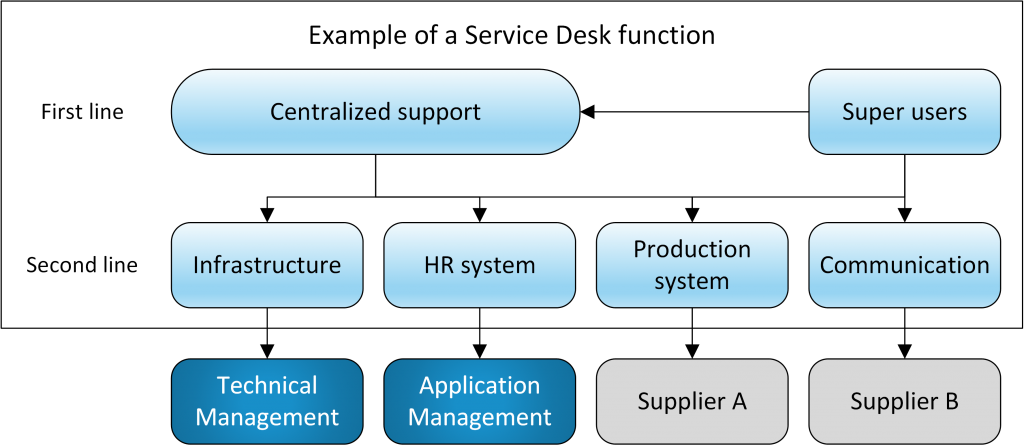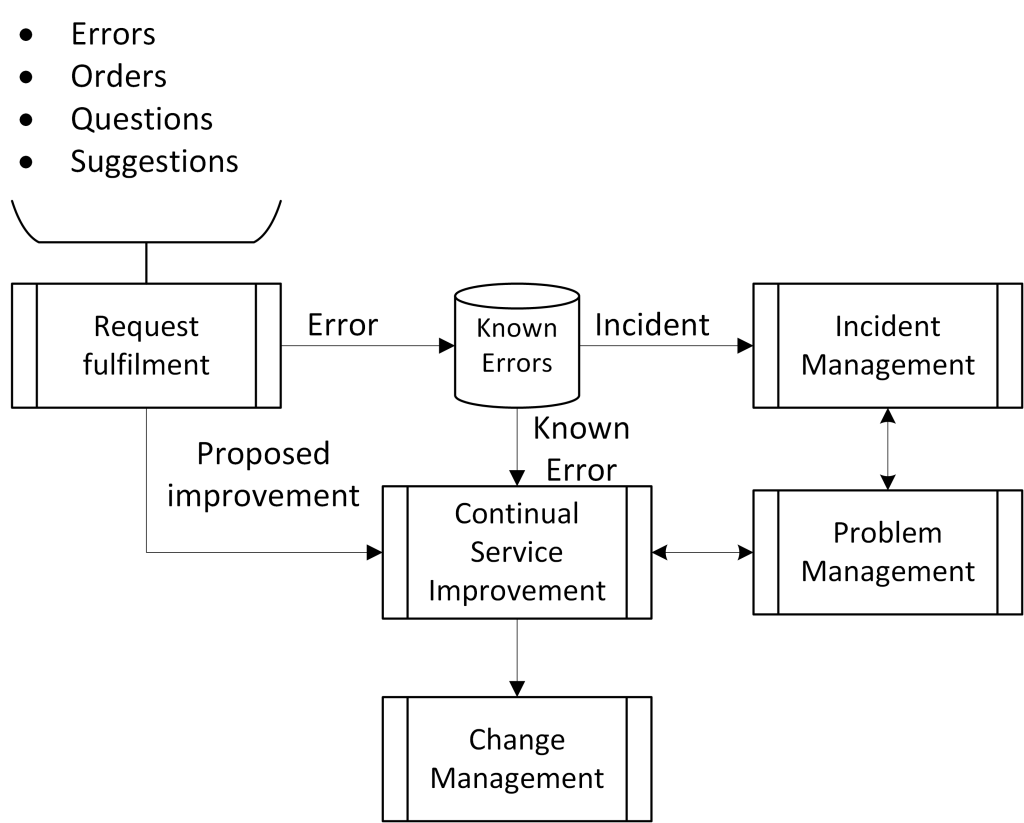Service Desk is an important part of the IT organization as it is the primary contact with the business’s users. As well as managing incidents and orders, Service Desk acts as the interface between IT and the users for all types of issues.
A well-functioning Service Desk can often compensate for other shortcomings within the IT organization, but a poorly functioning Service Desk can result in a poor reputation throughout the business, even if the rest of the IT organization is functioning effectively. The function is the IT organization’s outward face towards the business and is thus often what the users perceive as the IT department.


Purpose
The purpose of Service Desk is to provide an effective and clear communication channel between the IT organization and the business’s users. This means that information from the IT organization to the users .should also go via Service Desk. The users will thus naturally turn to Service Desk when they have questions, and moreover the staff on Service Desk will always be familiar with the information that is provided.
Service Desk also functions as a hub for internal ticket management within the IT organization. The Coordination process is managed by Service Desk and includes all issues that are to be implemented within the IT organization. Suggestions for improvement from users must be registered and forwarded to the function concerned. Incidents and orders that are dealt with by an external partner are managed by Service Desk. The user will receive feedback trough Service Desk. Having control of the flow of issues is a cornerstone in the IT organization and all other functions are dependent on statistics and reports on how this functions.
Responsibility
Service Desk is responsible for all contact with the users, regardless of which part of the IT organization is handling the issue. Naturally, all staff within the IT organization occasionally have direct contact with users. However, it is the function’s responsibility that contact takes place according to set procedures.
The function also has overall responsibility for and coordination of all issues within Operation. The coordination entails having control of and distributing ongoing issues, as well as regulating the workload placed on resources within Technical Management and Application Management.
Service Desk’s responsibility comprises, but is not limited to:
- Registration of all issues received from the users
- Performing initial diagnosis and support
- Resolving incidents when possible
- Executing documented orders from users
- Escalating issues that cannot be resolved within agreed time parameters
- Finalizing and checking all resolved incidents and service requests
- Conducting surveys as agreed
- Communication with the users – keeping them informed about ongoing issues, notifying them of forthcoming changes or agreed stoppages etc.
- Updating existing documentation such as known errors and temporary solutions
- Coordination of resources within Technical Management and Application Management
Organization and working method
The core of a Service Desk is that it should be the single point of contact (SPOC) between IT and users. Many organizations choose to use smaller groupings or individual users with local responsibility for support (super users), who have specialist expertise in certain systems or parts of the business.
How this is structured, whether it is one or several groupings, doesn’t really matter. What is important is that Service Desk acts as a single function where all groups use the same ticket management system, the same documentation sources and the same procedures. A Service Desk can thus include staff who are not organizationally employed within the IT organization.
Users should not need to wonder about where they should address a question or report an Incident. It is therefore important that the Service Desk function is structured so that all groupings with which the user first comes into contact can register and manage all types of issues. This section is called first line support and is usually managed by a central Service Desk grouping.
If the person who takes the issue in the first line cannot resolve the issue, it is passed to more specialized groups. These groups are called second line support. It is here it becomes important that all groups use the same system for ticket management so that it is simple to send tickets between different groupings. Examples of second line support can be more advanced technical expertise or hands-on application support.
Issues which are really tricky to resolve or where the IT organization does not have its own advanced expertise are passed on one level to third line support. This level is not counted as a part of the Service Desk and is made up of, for example, other functions within the IT organization or external suppliers.

Types of issues and processes
The difference between types of issues is interpreted in as many different ways as there are IT organizations. Each organization has to find its own definition which works within the prevailing conditions.
The definition of types of issue in TRIM is based on the statistics which the IT organization needs to present. One of the most common reports is the number of issues per type and category. The categories follow the service structure (described in more detail in the chapter on Service Catalogue Management) and is the same regardless of type of issue. A clear differentiation between types of issue thus produces better reports on how the IT environment is functioning. For example, a report on the number of incidents in the accounting system should not present anything other than unexpected disturbances. If the ‘incident’ issue type contains more items, for example, questions and orders, then the report says nothing more than that there has been a number of issues within the category. If, on the other hand, the report only contains really unexpected disruptions to the service, it is a measure of how the service is functioning and is a good basis for future improvement measures.
If the IT organization is not able to clearly sort the issues which come in, it is difficult to institute effective improvement measures. Service Desk is usually the function which manages this sorting of different types of issues and has a major responsibility in ensuring it is correct.
All incoming issues to Service Desk are managed initially as a request (service request) in the Request Fulfilment process. Questions and orders are processed and concluded within the process. Errors in the IT environment which come in are checked against the list of known errors. If there is a known error, a temporary measure is performed according to the documentation, and the issue is passed on as a proposed improvement in the Continual Service Improvement process. Within the parameters of Continual Service Improvement, based on the number of issues concerning known errors, the forum concerned can then decide to initiate an orderly problem solving procedure in the Problem Management process. The resulting solution is subsequently evaluated and if the forum chooses to resolve the problem entirely in the IT environment it is then managed via the Change Management process.
If the error is not registered as a known error, an incident is registered in the Incident Management process and initial diagnosis commences. If Service Desk is not able to solve the incident using the knowledge that is available, a problem record shall be created and managed in the Problem Management process. When the problem is resolved or a temporary solution has been found, the error is rectified in the IT environment and the incident record is closed.
Issues which do not fit in any of the types, or where there is no procedure for managing an issue, are passed on as an improvement proposal to the concerned Function. It is not Service Desk’s role to act as a detective on behalf of the IT organization or to set up procedures that do not exist.

With this division of issues into different types, it is easy for the IT organization to obtain a picture of how many errors there currently are in the IT environment, how many questions there are from the users (training requirements), and how many known errors and problems for which there are actually temporary solutions, but still uninvestigated.
Input
The overall input to Service Desk comprises questions and orders from the business’s users. More specifically, input consists of:
- Error notification
- Questions
- Orders
- Proposals for improvements
- Feedback on how the delivery of IT services is functioning
Output
The overall output from Service Desk is satisfied users. More specifically, output consists of:
- Resolved incidents
- Processed orders
- Escalated proposals for improvements
- Reports
Documentation
All documents produced by the function should be available in a business system. The most important documents are:
- Procedures for ticket management including
- Registration
- Categorization
- Escalation
- Closing of issues
- Procedures for dissemination of information
- Coordination procedures
Relationships with other processes and functions
Service Desk has links to many other processes and functions. The most common are listed here:


